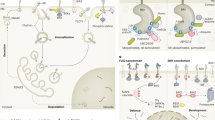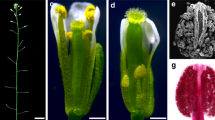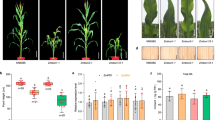Abstract
Most multicellular organisms use steroids as signalling molecules for physiological and developmental regulation. Two different modes of steroid action have been described in animal systems: the well-studied gene regulation response mediated by nuclear receptors1,2, and the rapid non-genomic responses mediated by proposed membrane-bound receptors3,4. Plant genomes do not seem to encode members of the nuclear receptor superfamily5. However, a transmembrane receptor kinase, brassinosteroid-insensitive1 (BRI1), has been implicated in brassinosteroid responses6,7. Here we show that BRI1 functions as a receptor of brassinolide, the most active brassinosteroid. The number of brassinolide-binding sites and the degree of response to brassinolide depend on the level of BRI1 protein. The brassinolide-binding activity co-immunoprecipitates with BRI1, and requires a functional BRI1 extracellular domain. Moreover, treatment of Arabidopsis seedlings with brassinolide induces autophosphorylation of BRI1, which, together with our binding studies, shows that BRI1 is a receptor kinase that transduces steroid signals across the plasma membrane.
This is a preview of subscription content, access via your institution
Access options
Subscribe to this journal
Receive 51 print issues and online access
$199.00 per year
only $3.90 per issue
Buy this article
- Purchase on Springer Link
- Instant access to full article PDF
Prices may be subject to local taxes which are calculated during checkout



Similar content being viewed by others
References
Beato, M., Herrlich, P. & Schutz, G. Steroid hormone receptors: many actors in search of a plot. Cell 83, 851–857 (1995).
Mangelsdorf, D. J. et al. The nuclear receptor superfamily: The second decade. Cell 83, 835–839 (1995).
Wehling, M. Specific, nongenomic actions of steroid hormones. Annu. Rev. Physiol. 59, 365–393 (1997).
Schmidt, B. M. et al. Rapid, nongenomic steroid actions: A new age? Front. Neuroendocrinol. 21, 57–94 (2000).
The Arabidopsis Genome Initiative. Analysis of the genome sequence of the flowering plant Arabidopsis thaliana. Nature 408, 796–815 (2000).
Li, J. & Chory, J. A putative leucine-rich repeat receptor kinase involved in brassinosteroid signal transduction. Cell 90, 929–938 (1997).
He, Z. et al. Perception of brassinosteroids by the extracellular domain of the receptor kinase BRI1. Science 288, 2360–2363 (2000).
Mandava, N. B. Plant growth-promoting brassinosteroids. Annu. Rev. Plant Physiol. Plant Mol. Biol. 39, 23–52 (1988).
Li, J., Nagpal, P., Vitart, V., McMorris, T. C. & Chory, J. A role for brassinosteroids in light-dependent development of Arabidopsis. Science 272, 398–401 (1996).
Wang, Z.-Y. & Chory, J. in Recent Advances in Phytochemistry Vol. 34, Evolution of Metabolic Pathways (eds Romeo, J. T., Ibrahim, R., Varin, L. & DeLuca, V.) 409–431 (Elsevier Science, Oxford, 2000).
Clouse, S. D., Langford, M. & McMorris, T. C. A brassinosteroid-insensitive mutant in Arabidopsis thaliana exhibits multiple defects in growth and development. Plant Physiol. 111, 671–678 (1996).
Schumacher, K. & Chory, J. Brassinosteroid signal transduction: still casting the actors. Curr. Opin. Plant Biol. 3, 79–84 (2000).
Friedrichsen, D. M., Joazeiro, C. A., Li, J., Hunter, T. & Chory, J. Brassinosteroid-insensitive-1 is a ubiquitously expressed leucine-rich repeat receptor Serine/Threonine kinase. Plant Physiol. 123, 1247–1256 (2000).
Asami, T. et al. Characterization of brassinazole, a triazole-type brassinosteroid biosynthesis inhibitor. Plant Physiol. 123, 93–100 (2000).
Choe, S. et al. The DWF4 gene of Arabidopsis encodes a cytochrome P450 that mediates multiple 22alpha-hydroxylation steps in brassinosteroid biosynthesis. Plant Cell 10, 231–243 (1998).
Clouse, S. & Sasse, J. Brassinosteroids: Essential regulators of plant growth and development. Annu. Rev. Plant Physiol. Plant Mol. Biol. 49, 427–451 (1998).
Noguchi, T. et al. Brassinosteroid-insensitive dwarf mutants of Arabidopsis accumulate brassinosteroids. Plant Physiol 121, 743–752 (1999).
Fujioka, S., Noguchib, T., Takatsutod, S. & Yoshida, S. Activity of brassinosteroids in the dwarf rice lamina inclination bioassay. Phytochemistry 49, 1841–1848 (1998).
Luo, W., Janzen, L., Pharis, R. P. & Back, T. G. Bioactivity of brassinolide methyl ethers. Phytochemistry 49, 637–642 (1998).
Trotochaud, A. E., Jeong, S. & Clark, S. E. CLAVATA3, a multimeric ligand for the CLAVATA1 receptor-kinase. Science 289, 613–617 (2000).
Torii, K. U. et al. The Arabidopsis ERECTA gene encodes a putative receptor protein kinase with extracellular leucine-rich repeats. Plant Cell 8, 735–746 (1996).
Jinn, T. L., Stone, J. M. & Walker, J. C. HAESA, an Arabidopsis leucine-rich repeat receptor kinase, controls floral organ abscission. Genes Dev. 14, 108–117 (2000).
Yamamuro, C. et al. Loss of function of a rice brassinosteroid insensitive1 homolog prevents internode elongation and bending of the lamina joint. Plant Cell 12, 1591–1605 (2000).
Li, J., Biswas, M. G., Chao, A., Russell, D. W. & Chory, J. Conservation of function between mammalian and plant steroid 5alpha- reductases. Proc. Natl Acad. Sci. USA 94, 3554–3559 (1997).
Seto, H. et al. A general approach to synthesis of labeled brassinosteroids: preparation of [25,26,27-2H7]brassinolide with 60% isotopic purity from the parent brassinolide. Tetrahedr. Lett. 39, 7525–7528 (1998).
Fankhauser, C. et al. PKS1, a substrate phosphorylated by phytochrome that modulates light signaling in Arabidopsis. Science 284, 1539–1541 (1999).
Acknowledgements
We thank M. Chen for comments and L. Barden for technical assistance on the manuscript; D. Vafeados for technical assistance; and D. Friedrichsen for providing the BRI1–GFP line. This work was supported by a grant from the USDA and the Howard Hughes Medical Institute to J.C., and by a Grant-in-Aid for Scientific Research from the Ministry of Education, Science, Sports, and Culture of Japan to S.F.. Z.W. is an NSF postdoctoral fellow and J.C. is an Associate Investigator of the Howard Hughes Medical Institute.
Author information
Authors and Affiliations
Corresponding author
Rights and permissions
About this article
Cite this article
Wang, ZY., Seto, H., Fujioka, S. et al. BRI1 is a critical component of a plasma-membrane receptor for plant steroids. Nature 410, 380–383 (2001). https://doi.org/10.1038/35066597
Received:
Accepted:
Issue Date:
DOI: https://doi.org/10.1038/35066597
This article is cited by
-
An E2-E3 pair contributes to seed size control in grain crops
Nature Communications (2023)
-
Coordinated regulation of vegetative phase change by brassinosteroids and the age pathway in Arabidopsis
Nature Communications (2023)
-
Crosstalk between brassinosteroid signaling and variable nutrient environments
Science China Life Sciences (2023)
-
Physiological and Transcriptomic Analyses of the Effects of SlBRI1 Expression Levels on the Drought Tolerance of Tomato Seedlings
Journal of Plant Growth Regulation (2023)
-
Evolutionary analysis and functional characterization of BZR1 gene family in celery revealed their conserved roles in brassinosteroid signaling
BMC Genomics (2022)
Comments
By submitting a comment you agree to abide by our Terms and Community Guidelines. If you find something abusive or that does not comply with our terms or guidelines please flag it as inappropriate.



